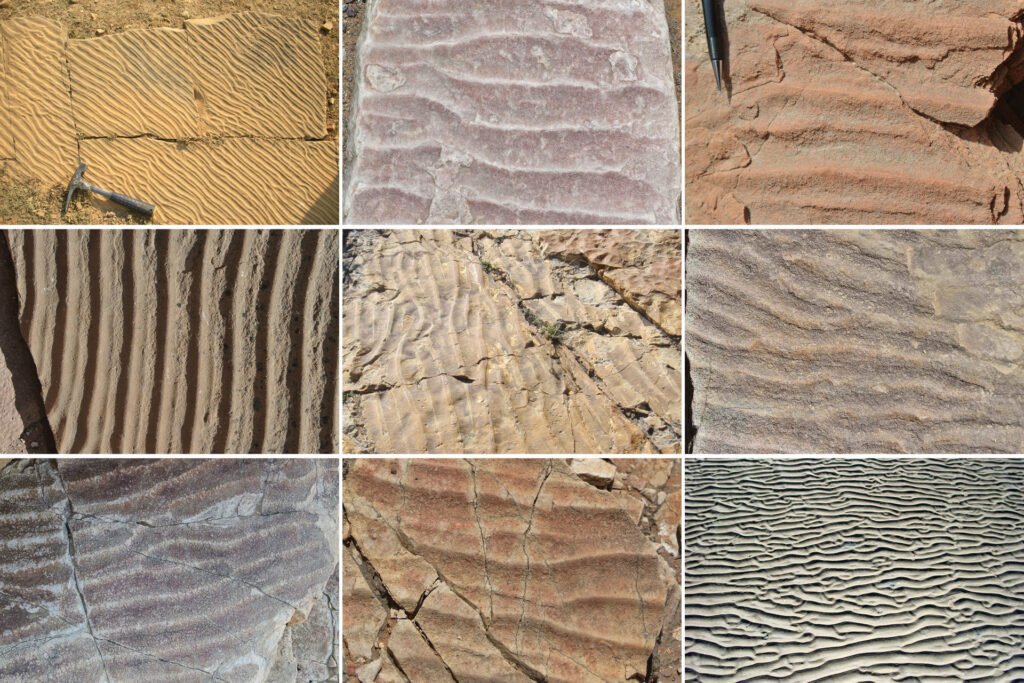‘Fingerprints’ of Ancient Weather Conditions

‘Fingerprints’ of Ancient Weather Conditions
When a coastal tide rolls out, it may monitor lovely ripples withinside the briefly uncovered sand. These equal undulating styles also can be visible in historical, petrified seabeds which have been uncovered in numerous elements of the arena and preserved for hundreds of thousands or maybe billions of years.
Geologists appearance to historical sand ripples for clues to the environmental situations wherein they shaped. For instance, the spacing among ripples is proportional to the intensity of the water and the scale of the waves that molded the underlying ripples.
But sand ripples aren’t continually flawlessly parallel, carbon-copies of every other, and may show numerous kinks and sworls. Can those greater subtle, reputedly random deviations or defects inform us some thing approximately the situations wherein a sandy seabed shaped?
The answer, consistent with researchers from MIT and elsewhere, is yes. In a paper posted on-line and acting withinside the Oct. 1 trouble of Geology, the group reviews that a few not unusualplace defects determined in each historical and cutting-edge seabeds are related to positive wave situations. In particular, their findings advise that ripple defects such as hourglasses, zigzags, and tuning forks have been probable formed during periods of environmental flux — for instance, at some stage in robust storms, or great adjustments in tidal flows.
“The kind of disorder you spot in ripples may want to let you know approximately how dramatic the shifts in climate situations have been on the time,” says Taylor Perron, partner professor of geology and partner head of MIT’s Department of Earth, Atmospheric and Planetary Sciences (EAPS). “We can use those defects as fingerprints to inform now no longer simply what the common situations have been withinside the past, however how matters have been changing.”
Ripple defects in historical sandbeds may additionally affect how fluids go with the drift thru sedimentary rocks, along with underground reservoirs that preserve water, oil and gas, or maybe saved carbon dioxide, consistent with Perron.
In addition, he says, ripple styles in cutting-edge sand act to roughen the seabed, slowing down ocean currents close to the shore. Knowing how ripples extrade in reaction to moving waves and tides might also additionally consequently assist are expecting coastal erosion and flooding.
Perron’s co-authors are at the paper are former MIT graduate pupil Kimberly Huppert ’11, PhD ’17, former undergraduate and cutting-edge postdoc Abigail Koss ’12, Paul Myrow of Colorado College, and previous undergraduate Andrew Wickert ’08 of the University of Minnesota.
Wrinkles preserved
The group commenced searching into the importance of ripple defects numerous years ago, whilst Myrow, who on the time changed into spending his sabbatical at MIT, confirmed Perron a few snap shots that he had taken of sedimentary rocks etched with ripples and grooves. The rocks have been, in fact, historical sandbeds that have been loads of hundreds of thousands of years old.
Wave-sculpted ripples shape as waves tour throughout the floor of a frame of liquid. These waves purpose water below the floor to circle round and round, producing oscillating flows that choose up sand grains and set them down in a method that ultimately carves out troughs and grooves at some stage in the sandbed.
But how may want to such sensitive styles be preserved for hundreds of thousands of years? Perron says that numerous methods may want to basically set ripples in place. For instance, if the water stage all at once dropped, it can go away a sand mattress’s ripples uncovered to the air, drying them out and hardening them to a few extent, in order that they retained their styles at the same time as greater sediment slowly layered itself on pinnacle of them over billions of years.
Similarly, if a finer sediment like dust or silt covers a sand mattress, along with after a big storm, those sediments may want to blanket the prevailing ripples. As Perron explains, this will basically “armor them, retaining the waves from eroding the ripples earlier than greater sediment buries them.” Over time, the sediments become rock as they may be buried deep beneath Earth’s floor. Later, the rock covering the ripples can obviously erode away, exposing the preserved ripples on the floor once more.
In searching through snap shots of sand ripples, Perron and Myrow observed small defects such as tuning forks, zigzags, and hourglasses, throughout each historical and cutting-edge sandbeds.
“People have observed those defects earlier than, however we wondered, are they simply random, or do they honestly incorporate a few information?” Perron says.
Paddling thru waves
The researchers got down to examine the numerous wave situations that generate positive ripple styles and defects. To do this, they constructed an acrylic wave tank measuring 60 centimers wide, 50 centimers deep, and seven meters long. At one give up of the tank, they connected a motor-pushed paddle, which swished from side to side to generate waves that traveled throughout the tank.
At the opposite give up of the tank, they erected an synthetic sloping “beach” protected in a polymer mesh. This setup served to limit any wave reflections: As a wave crashed onto the synthetic beach, the strength dissipated in the mesh in place of splashing again and influencing oncoming waves.
The group stuffed the tank with a 5-centimeter-thick mattress of exceptional sand and sufficient water to attain forty centimeters in intensity. For every experiment, they set the paddle to graceful from side to side at a consistent distance, and recorded the sand mattress as ripples shaped. At a positive point, they discovered that the ripples — and in particular, the spacing among the ripples — reaches a strong, regular sample. They recorded this spacing, together with the velocity and amplitude of the paddle, and then, over 32 experimental runs, both elevated or reduced the paddle’s movement, inflicting the ripples to morph once more to both a much broader or narrower spacing.
Interestingly, they determined that, withinside the method of fixing to a brand new spacing, ripples shaped middleman defects such as zigzags, hourglasses, and tuning forks, relying at the wave situations set via way of means of the tank’s paddle.
As the researchers shortened the paddle’s again-and-forth movement, this created shorter waves, narrower ripples, and styles that resembled hourglasses. If the paddle’s movement changed into shortened even further — developing faster, shorter waves — a sample of “secondary crests,” wherein present ripples regarded to shape temporary “shadow” ripples on both side, took over. When the researchers widened the paddle’s movement, producing longer waves, the ripples shaped zigzag styles as they shifted to a much broader spacing.
“If you spot those styles of defects in nature, we argue that the seabed changed into present process a few sort of extrade in climate situations, tides, or some thing else that affected water intensity or waves, likely over the direction of hours or days,” Perron says. “For instance, if you’re seeing plenty of secondary crests, you may inform there has been a quite huge extrade withinside the waves rather than a smaller extrade, which may come up with hourglasses instead.”
The researchers discovered that during all scenarios, styles such as tuning forks cropped up, even after ripples had reached a brand new, strong spacing.
“These tuning forks generally tend to paste round for a long term,” Perron says. “If you spot those in cutting-edge or historical rock, they advise a seabed skilled a extrade, however then the situations remained steady, and the mattress had a long term to adjust.”
Going forward, Perron says geologists can use the group’s consequences as a blueprint to attach positive ripple defects with the water situations that can have created them, in each the cutting-edge surroundings and withinside the historical past.
“We suppose those small defects can let you know plenty greater approximately an historical surroundings than simply what the common length of the waves and water intensity changed into,” Perron says. “They may want to let you know if it changed into an surroundings that had tides that have been big sufficient to extrade ripples via way of means of this much, or if an area changed into experiencing periodic storms, even billions of years ago. And if we discover historical wave ripples on Mars, we’ll realize the way to study them.”
This studies changed into supported, in part, via way of means of the National Science Foundation.
![Hubble Finds “Missing Link” Black Hole Tearing Apart a Star That Passed Too Close [Video]](https://aspiredworlds.com/wp-content/uploads/2022/07/Mid-Sized-Black-Hole-Eating-Star-scaled-1-300x169.jpg)






